Primary Source Set
Jim Crow South: Life in North Carolina Post Civil War-1930’s
Following the long history of enslavement and the resulting Civil War, states within the U.S. adopted racist and segregationist policies that became known as Jim Crow laws. The years that these laws were in place (starting after the Civil War through 1968) came to be known as the Jim Crow era. This assortment of newspapers, photographs, and other types of documentation describes the lived experiences of people in North Carolina during Jim Crow post Civil War to the 1930’s.
Proceed with caution and care through these materials as the content may be disturbing or difficult to review. Specifically, there are mentions and descriptions of racist and white supremacist violence and murders, oppression based on race, racist and white supremacist language, and offensive former race labels. Please read DigitalNC’s Harmful Content statement for further guidance.
Time Period
1865-1930's
Grade Level
Undergraduate

The South II
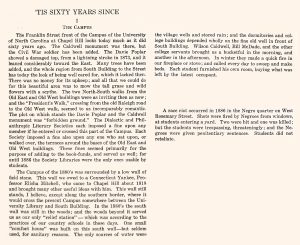
Tis Sixty Years Since: A Story of the University of North Carolina in the 1800s
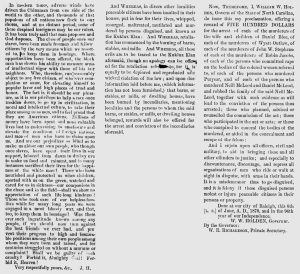
The weekly standard. (Raleigh, N.C.) [7/27/1870]
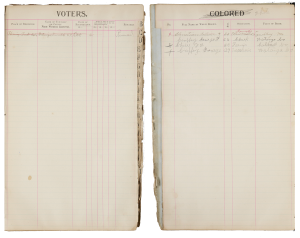
Blowing Rock's First Voter Registration Poll
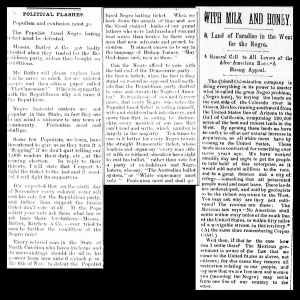
The Wilmington herald. (Wilmington, N.C.) [10/18/1894]
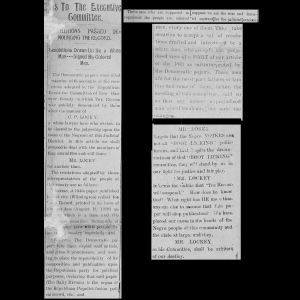
'To the Executive Committee' The Daily Record. (Wilmington, N.C.) [8/26/1898]
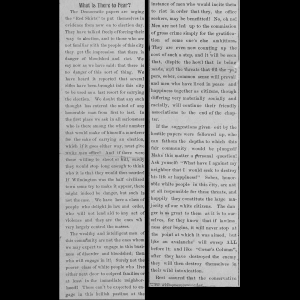
'What Is There to Fear?' The Daily Record. (Wilmington, N.C.) [10/20/1898]
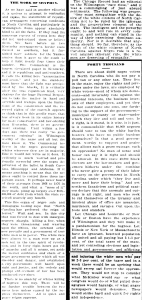
The semi-weekly messenger. (Wilmington, N.C.) [11/25/1898]
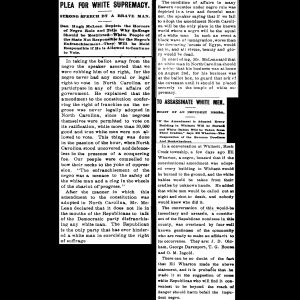
Greensboro telegram. (Greensboro, N.C.) [7/7/1900]

'Negroes Must Be Given Equal Accommodations With Whites On Rwy’s' The Charlotte news. (Charlotte, N.C.) [7/8/1907]
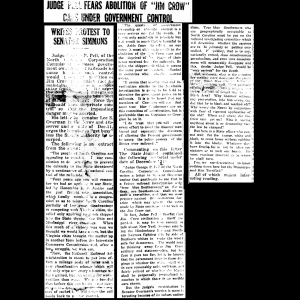
'Judge Pell Fears Abolition of “Jim Crow” Cars Under Government Control' The Raleigh independent. (Raleigh, N.C.) [12/21/1918]
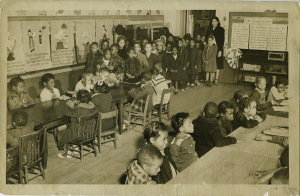
Mrs. Dusenbury and Mrs. Cooper Classes, Hill Street School [1919]
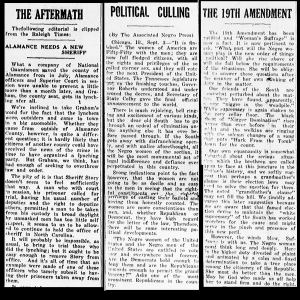
The Raleigh Independent. (Raleigh, N.C.) [9/4/1920]
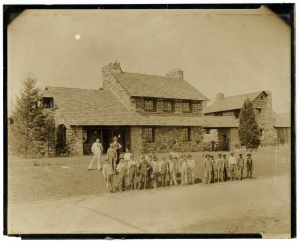
Chinqua-Penn Plantation Gate House
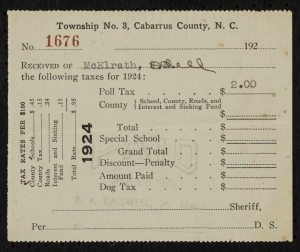
Poll Tax Receipt of Odell McElrath, 1924
Background
The Advent of Slavery in the United States
Slavery had become a global institution with the rise of colonialism and the ideology of distinct races; a chosen hierarchy accompanied this construct, now known as white supremacy, and was used to justify the violence enacted through colonization. As the now named Americas were colonized, enslaved people from Africa began to be brought to the colonies during the early 1600’s, and the practice of slavery grew exponentially from this point.
Slavery was a strongly held American institution until the idea of abolition began to gain more widespread support in the early and mid-1800’s. Many people had been strongly advocating against the violent practice of slavery and undermining its power over enslaved people since its inception, and the 1800’s saw a culmination of these efforts. Regardless of the motivations, whether moral or economic, the reality of abolition became clear and a Civil War (1861-1865) resulted between the industrial Northern states within the Union and the Southern states, which held most of the enslaved population and, consequently, those that most directly profited from the continued practice of slavery.
Post-Civil War Reconstruction
After the Emancipation Proclamation (1863) issued by president Lincoln declaring the end of slavery and then the Union’s victory in the Civil War (1865), the Reconstruction period began in the South to rebuild and restructure the post-war region, circa 1865-1877. The 13th amendment was ratified into the Constitution and officially prohibited the practice of slavery within the United States. However, the legacy of slavery and racism persisted; its influence could be found in the language of the 13th amendment that abolished slavery (except for slavery in the form of being incarcerated), in the newly created laws that continued white supremacist ideology, and in the everyday actions and anti-Black beliefs held by individuals throughout the country.
“Jim Crow”
The term ‘Jim Crow’ came from the phrase coined by a popular song used in minstrel shows, which were performances centered on mocking African Americans. This is also where the act of Black-face gained popularity. The racist phrase ‘Jim Crow’ became the name given to the era of repression and segregation in the United States marked by racist and segregationist laws. It prohibited non-white people from certain areas or from engaging in certain activities (e.g. drinking from separate water fountains or only being allowed to sit in designated sections of public venues). More discreet laws were implemented discriminatorily, like requiring a poll tax or written test in order to vote. This began primarily after the Reconstruction period in response to the increased participation of Black people in the community and politics, especially with the success of Black politicians in being elected in Southern states.
These laws were in place throughout the country, not only the South, although the South’s history with slavery and resentment from its abolition among politicians and former slaveholders created a hostile environment in the region. Many people began to identify certain areas as “Sundown Towns” because they knew them to be unsafe for any Black person to visit after dark. Some towns even had signs that proclaimed the entire area “for whites only,” much like those posted by businesses or on public restrooms throughout the country.
People experienced oppression both structurally through these racist laws and personally from individual people. Strongly held racist ideologies gave rise to white supremacist organizations, like the Klu Klux Klan, and spontaneous mobs that resulted in terrorizing Black people and the practice of lynchings. The reality of life throughout the South was marred by violence and oppression, and these occurrences became mostly Southern violence.
Resistance to Oppression
In response, communities began to organize and resist structural and communal oppression. Many Black communities were founded during this time due to segregation, and their exclusion from public life saw the creation of many Black-owned businesses. In North Carolina, there were multiple Black-run newspapers that reported both on the issues their community was facing and that celebrated their joys and accomplishments. For example, you could find on a front page both an update on possible desegregation of interstate transportation, as well as congratulations for the recently graduated local high school students.
While the passing of the Civil Rights Act in 1965 and the Fair Housing Act of 1968 saw the legal end of explicit Jim Crow laws, some would argue that Jim Crow persists in the racist policies and practices still ingrained in many institutions, like under-funding historically Black communities. By exploring the documented history and the lived experiences of people during this time in North Carolina, we can understand its impacts and lasting effects on people and our communities.
Discussion Questions
Wilmington Massacre
- Compare the article written by The Daily Record prior to the massacre and then the article by the Semi-Weekly after the massacre. With no other information, what would you conclude to have happened during the Wilmington Massacre?*
- Now read this article on the background of the events. Did your perspective of the events change? What information was brought to light that was not included, was altered, or was denied by the semi-weekly?*
- What political or personal agendas/perspectives were at play in the publishing of the daily record and the semi-weekly? How might people have determined the truth of the events in 1898?**
- When analyzing mass media (e.g newspapers, tv news outlets, etc.), how can people determine the underlying agendas that influence how information is presented?**
- In a world supposedly filled with “fake news,” how do people determine what is “true” news? Should news be true to be considered information? If so, is untrue news not information? Why or why not?**
- How does morality and ethics relate to truth and what does it mean for certain ideologies (e.g. integration or racial justice) to become societal norms/truths?**
Greensboro Telegram (1900) and Goodbye Carolina (1964)
- Read the article “Plea for White Supremacy: Strong Speech by a Brave Man” from the Greensboro Telegram and then watch the “Goodbye Carolina” video from 1964. How do these pieces of media stand in opposition to each other?*
- Were the fears of mass Black migration to North Carolina if racial equality through voter’s rights were achieved as described in the article in the Greensboro Telegram a founded fear? Why or why not?**
- Review this 1962 article “Elections and Mass Media” by Stanley Kelley Jr. What role did mass media play in campaigning during the 1900 election cycle in North Carolina? How does it play a role in our elections today?*
- Read the article “Plea for White Supremacy: Strong Speech by a Brave Man” from the Greensboro Telegram and then watch the “Goodbye Carolina” video from 1964. How do these pieces of media stand in opposition to each other?*
Reality of Voting in NC
- Review this article on NCPedia’s website about the history of the poll tax in NC. What would you say the policy for access to voting would be before and after the amendment in 1919?*
- Now review these poll tax receipts (one and two), this voter registration list from Blowing Rock, NC, and this 1952 article regarding access to voting in NC. What do these documents tell you about the realities of voting and access to voting in North Carolina during Jim Crow? Do you think that access to voting was consistent across the state?**
- Based on historic methods of undermining access to voting, how do you think that legacy impacts us today? Can you find any evidence that confirms or refutes your suppositions?**
After reviewing the examples of newspaper articles from historically Black-owned newspapers and historically white-owned newspapers in North Carolina, what is the significance of having Black-run newspapers during this time?**
After viewing the classroom of Mrs. Dunesbury’s and Mrs. Cooper’s classroom, compare this to Jamestown, NC white school classroom. What differences do you notice? What does this tell you about the funding and support for these different schools?*
- Does this point to any issues with the “separate but equal” policy instituted through Plessy v. Ferguson? Why or why not?**
What can you conclude about the reality of the Jim Crow era in North Carolina based on these sources?**
* Questions that check for comprehension
** Questions that involve a “deeper dive” in conceptual and historical analysis
This primary source set was compiled by cal lane.
Updated January 2025